NZXT Kraken X40 Compact Liquid Cooling System Review: New Level of Cool?

Larger radiator and a large 140 mm fan, fortified pump and longer tubing, user-friendly software for management and monitoring – will that be enough to outperform the best air cooler?
Founded in 2004, NZXT Corporation has come to offer a rather extensive range of products including computer cases of various form-factors, power supply units, controllers, cables, accessories and cooling systems. Recently the company has also released two liquid cooling solutions known under the name of Kraken. As you probably know, a kraken is a legendary sea monster, the terror of Jack Sparrow.
We’ll tell you about the Kraken X40 today.
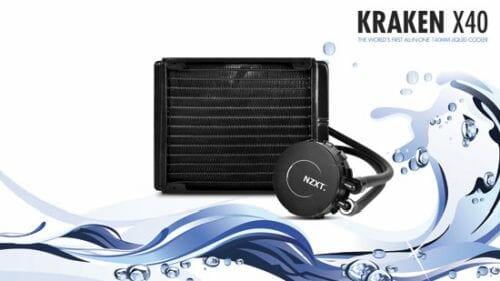
The senior X60 model will be covered in an upcoming review.
Technical Specifications and Recommended Pricing
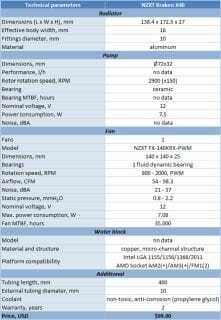
Packaging and Accessories
The NZXT Kraken X40 is shipped in a small cardboard box that has a picture of the product on its front side.
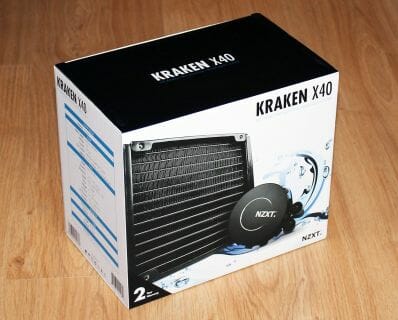
Detailed technical specs, key features and compatible platforms are printed on the other sides of the box.
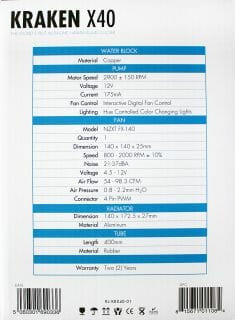
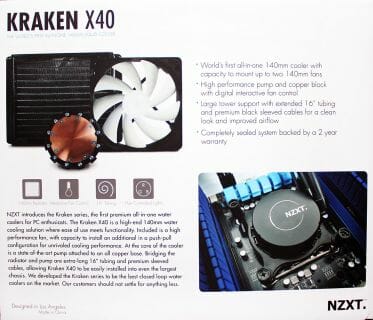

Inside the cardboard wrap there’s a tray with compartments for each of the system components.
The fan and radiator are additionally packed in individual cardboard wraps. So, the Kraken X40 components are protected well against any damage during transportation.
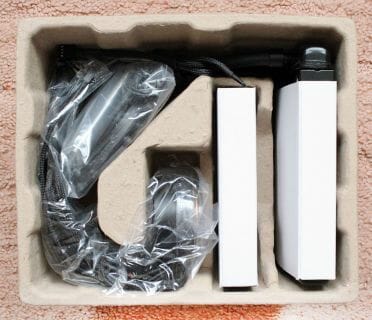
Besides the cooling system, the box contains two back-plates, retention plates and a fixing ring, screws and spacers, a user manual, and a software CD.
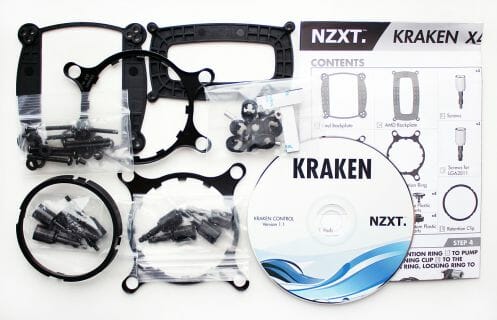
The NZXT Kraken X40 is manufactured in China and costs $99. It comes with a 2-year warranty.
Design and Functionality
The Kraken X40 represents the classic design of closed-loop liquid cooling systems. It consists of a waterblock combined with a pump, a radiator with fan, and connecting pipes.
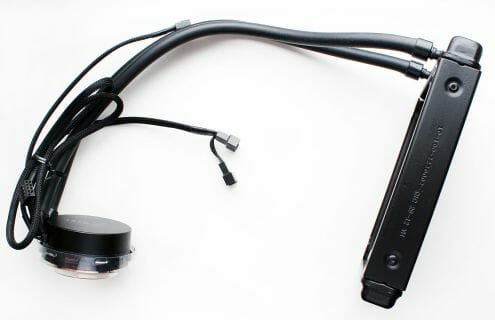
We’ve studied and tested such designs a lot of times, but the Kraken X40 is special in one respect:
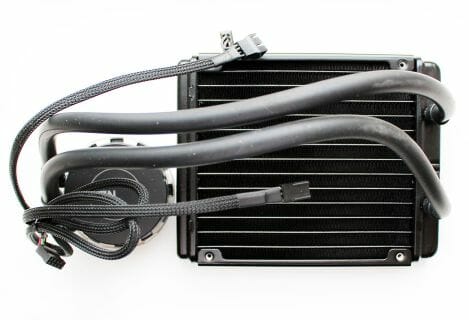
Of course, we mean its large radiator which measures 138.4 x 172.5 x 27.0 mm.
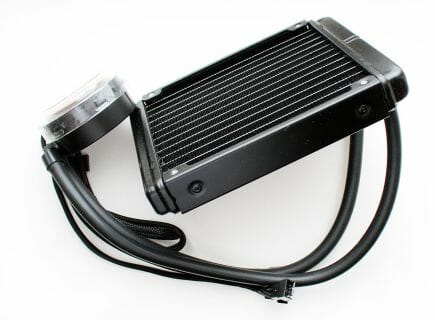
According to NZXT, the radiator’s surface area is enlarged by 36% in comparison with ordinary ready-made solutions with 120mm radiators. The coolant now moves along 13 flat pipes instead of 9-11 as usual.
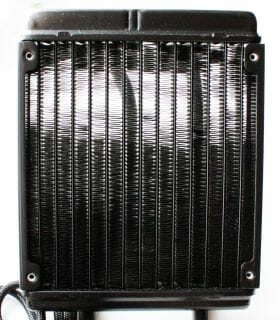
A stretch of corrugated aluminum ribbon is soldered (or even just glued) between the pipes. The radiator’s body is only 16 mm thick, so there are no advantages compared to other products based on the Asetek platform in this respect.
The radiator sticker tells you the product’s model name and power specs (12 volts, 7.5 watts). The power parameters must be those of the pump.
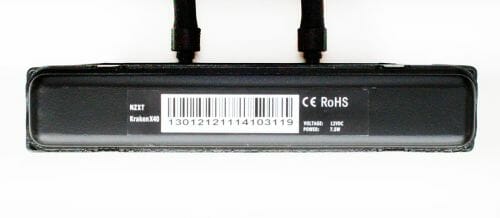
There are two fittings on the other side of the radiator. Pipes with an exterior diameter of 10 millimeters are press-fitted on them.
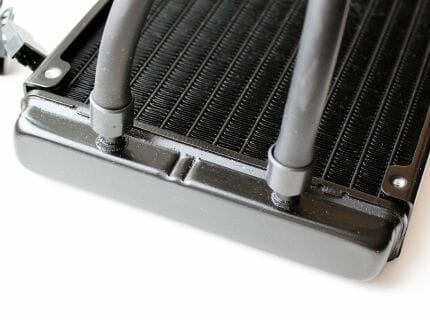
The length of the pipes has been increased from 300 to 400 mm, letting you place your NZXT Kraken X40 anywhere in your computer case.
The new waterblock/pump combo hasn’t changed visually. It still measures Ø72×32 mm. The performance of the pump is not specified.
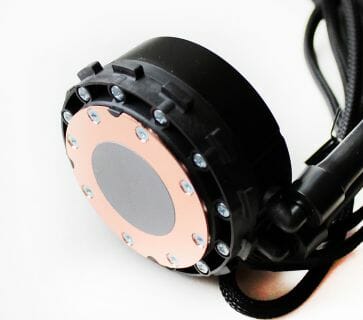
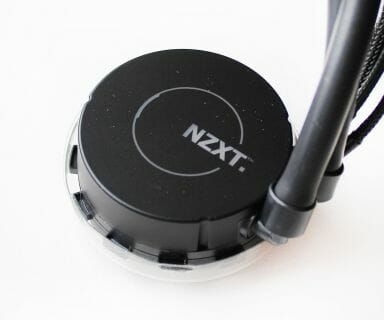
However, we can learn that the pump’s motor works at a speed of 2900 (±150) RPM, which our monitoring tools confirmed. There is a thin layer of high-efficiency thermal interface pre-applied on the waterblock’s base.
Removing the plastic cap, we can see an electric motor and a small PCB.
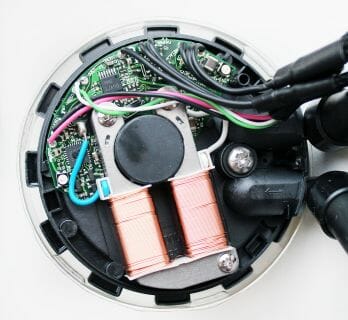
NZXT says that the copper waterblock has a microchannel structure like all Asetek-based models although NZXT doesn’t confirm (or reject) the affinity of the Kraken X40 with Asetek. The waterblock’s contact spot is finished well:
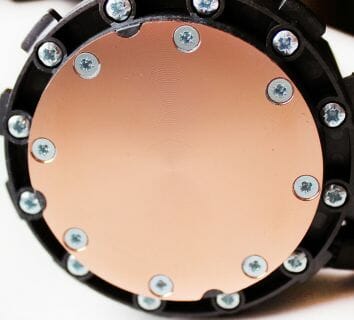
We’ve got the following thermal grease imprint on the convex heat-spreader of our CPU:
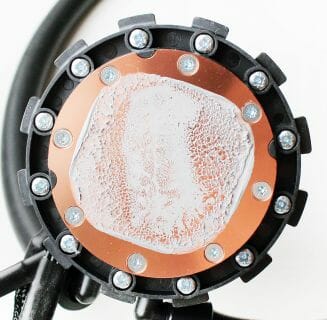
It’s clear that the pressure is the highest at the center of the waterblock and CPU heat-spreader.
The pump features nice-looking highlighting of the manufacturer’s logo.
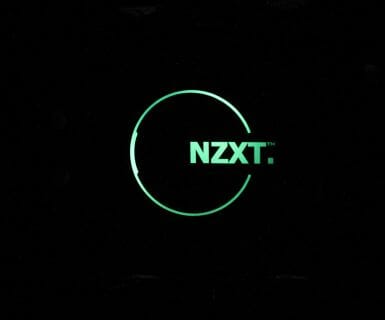
Its color and brightness can be regulated using special software we’ll discuss shortly.
The Kraken X40 is equipped with one 140mm NZXT FX-140 fan.
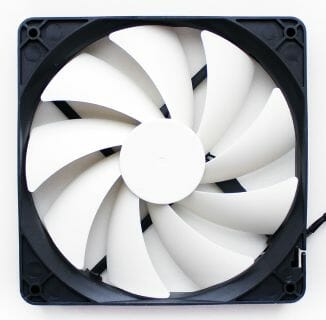
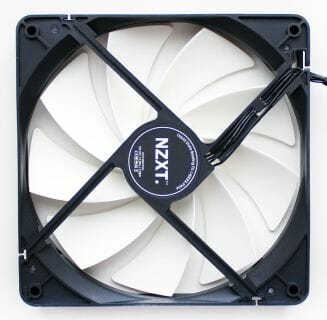
The 9-blade impeller with a diameter of 134 mm should cool the thin radiator well enough even at low speeds. It is PWM-regulated in a range of 800 to 2000 RPM. The fan is specified to produce an air flow of 54 to 98.3 CFM at 21-37 dBA of noise and a static pressure of 0.8 to 2.2 mm of water.
The fan’s 42mm motor runs on a fluid dynamic bearing. The sticker doesn’t provide much information:
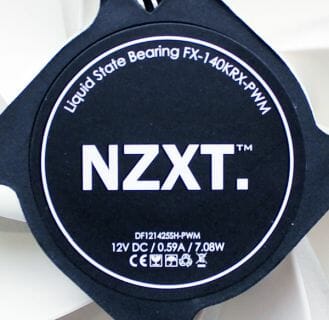
The bearing is specified to last for 35,000 hours or 4 years of continuous operation. The peak power consumption of the fan is said to be 7.08 watts although it was not higher than 5.3 watts according to our own measurements.
The fan is connected to a 4-pin cable that goes from the pump.
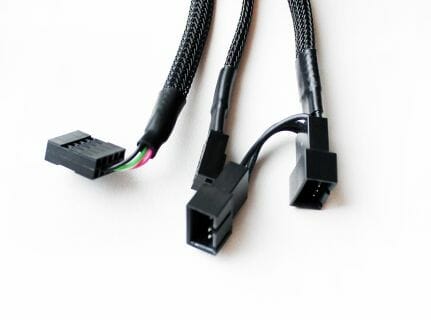
You can connect a second fan but it won’t be PWM-regulated. The pump’s cable is 240 mm long while the fan’s cable is 385 mm long. The pump is also connected to a mainboard’s 3-pin fan connector and USB header (with a 600mm cable). The latter is needed for the software aspect of the Kraken X40 which we will discuss shortly.
Compatibility and Installation
To accommodate the NZXT Kraken X40, your computer case must have at least one place for a 140mm fan. Such cases have become more popular nowadays, yet their market share is still rather small. Anyway, you can find a list of compatible computer cases at the NZXT website. The Kraken Case Compatibility V1.1 list includes half a hundred models already.
Since it has a version number, the list is going to be updated and extended. You may want to check it out if you plan to buy a Kraken X40.
As for compatibility of the waterblock with CPU platforms, there should be no problems at all since the Kraken X40 can be mounted on any modern Intel or AMD processor. The installation procedure is no different from that of other similar products we’ve tested before and is detailed in the user manual. It is overall the same for AMD…
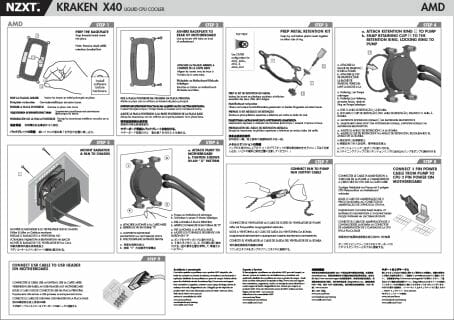
…and Intel platforms and consists of just a few simple steps.
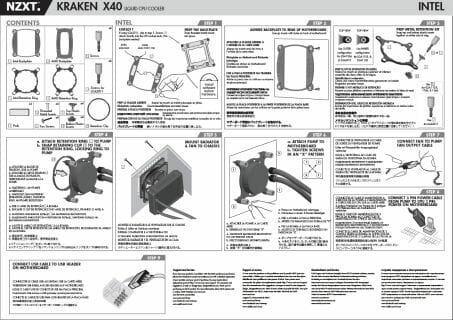
Our computer case Antec Twelve Hundred doesn’t have 140mm fans, so we had to test the Kraken X40 outside. We installed the waterblock on the CPU and put the radiator with fan down next to the computer on a piece of foam rubber.
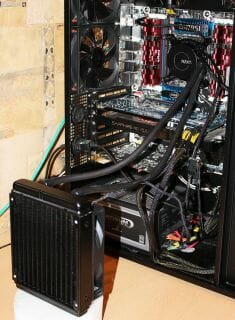
Fortunately, the cables and pipes were long enough to let us do so.
Software
One of the key features of the NZXT Kraken X40 is that it supports software-based fan monitoring and regulation. It comes with the Kraken Control v1.1.0 utility whose main screen shows the coolant temperature, the temperature of each CPU core, and the speed of the fans and pump.
Besides, in the top right corner of the window there is an operation mode switch that allows you to control the speed of the fan(s). The speed of the pump’s motor cannot be regulated.
The utility’s second tab shows you monitoring graphs with fan speed and CPU temperature data.
The third tab is called Fan Setting and allows to manually specify how the fan must change its speed depending on CPU temperature. This setting can be saved into a profile:
It seems to be the most valuable of the utility’s functions.
Besides, you can disable, enable or specify the color of the pump’s highlighting and make the color change depending on CPU temperature.
In the general settings you can choose an interface language and measurement units, enable the utility to start up automatically, turn on logging, and specify temperature and fan speed thresholds for notifications.
Even Davy Jones himself had no such power over his kraken as NZXT’s Kraken Control offers!
Testbed and Methods
The tests were performed inside a system case with the removed side panel. Our testbed was configured as follows:
- Mainboard: Intel Siler DX79SI (Intel X79 Express, LGA 2011, BIOS 0537 from 07/23/2012);
- CPU: Intel Core i7-3960X Extreme Edition, 3.3 GHz, 1.2 V, 6 x 256 KB L2, 15 MB L3 (Sandy Bridge-E, C1, 1.2 V, 6×256 KB L2, 15 MB L3);
- Thermal interface: default thermal paste layer on the base of the cooler and ARCTIC MX-4 (for Phanteks PH-TC14PE);
- System memory: DDR3 4 x 4GB Mushkin Redline (Spec: 2133 MHz / 9-11-10-28 / 1.65 V);
- Graphics card: AMD Radeon HD 7770 1 GB GDDR5 128 bit, 1000/4500 MHz with Deep Cool V4000 passive copper heatsink;
- System drive: Crucial m4 256 GB SSD (SATA-III,CT256M4SSD2, BIOS v0009);
- Drive for programs and games: Western Digital VelociRaptor (300GB, SATA-II, 10000 RPM, 16MB cache, NCQ) inside Scythe Quiet Drive 3.5” HDD silencer and cooler;
- Backup drive: Samsung Ecogreen F4 HD204UI (SATA-II, 2 TB, 5400 RPM, 32 MB, NCQ);
- System case: Antec Twelve Hundred (front panel: three Noiseblocker NB-Multiframe S-Series MF12-S2 fans at 1020 RPM; back panel: two Noiseblocker NB-BlackSilent PRO PL-1 fans at 1020 RPM; top panel: standard 200 mm fan at 400 RPM);
- Control and monitoring panel: Zalman ZM-MFC3;
- Power supply: Seasonic SS-1000XP Active PFC F3 1000 W (with a default 120 mm fan).
For the primary tests and summary diagrams we overclocked our six-core processor with the clock generator frequency set at 125 MHz, the multiplier at 35x and “Load-Line Calibration” enabled to 4.375 GHz. The nominal processor Vcore was increased to 1.385 V in the mainboard BIOS. After that we tested the new cooling systems at even higher frequency and voltage settings. Turbo Boost was disabled during this test session, and Hyper-Threading technology was enabled to increase the heat dissipation. The memory voltage was at 1.65 V and its frequency was 2000 MHz with 9-11-10-28 timings. All other parameters available in the mainboard BIOS and related to CPU or memory overclocking remained unchanged.
All tests were performed under Windows 7 Ultimate x64 SP1 operating system. We used the following software during our test session:
- LinX AVX Edition version 0.6.4 – to load the processor (memory – 4500 MB, Problem Size – 24234, two 11-minute cycles);
- Real Temp GT version 3.70 – to monitor the processor core temperatures;
- Intel Extreme Tuning Utility version 3.1.105.5 – for monitoring and visual control of all system parameters during overclocking.
So, the complete screenshot during the test session looks as follows:
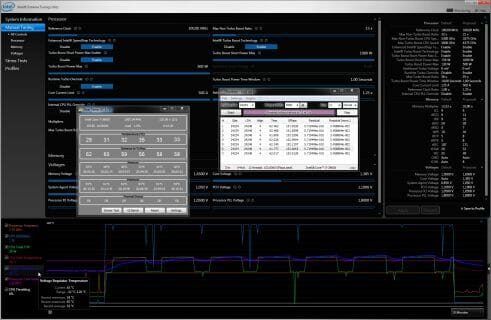
The CPU was loaded with two consecutive LinX AVX test runs with the settings as indicated above. The stabilization period for the CPU temperature between the two test cycles was about 8-10 minutes. We took the maximum temperature of the hottest CPU core for the results charts. Moreover, we will also provide a table with the temperature readings for all cores including their average values.
The ambient temperature was checked next to the system case with an electronic thermometer with 0.1 °C precision that allows hourly monitoring of the temperature changes over the past 6 hours. The room temperature during our test session varied between 23.0-23.5°C.
The noise level of each cooler was measured between 1:00 and 3:00 AM in a closed room about 20 m2 big using CENTER-321 electronic noise meter. The noise level for each cooler was tested outside the system case when the only noise sources in the lab were the cooler and its fan. The noise meter was installed on a tripod and was always at a 150 mm distance from the cooler fan rotor. The tested cooling systems were placed at the edge of the desk on a sheet of polyurethane foam. The lowest noise reading our noise meter device can register is 29.8 dBA and the subjectively comfortable noise level in these testing conditions was around 36 dBA (do not mistake it for the low noise level). The fan(s) rotation speed was adjusted in the entire supported range using our in-house controller by changing the voltage with 0.5 V increment.
Just like all the previously reviewed cooling systems, the new NZXT Kraken X40 will compete against the best air cooler out there – Phanteks PH-TC14PE. However, instead of the two default fans that are not particularly quiet we topped Phanteks heatsink with two Corsair AF140 fans:
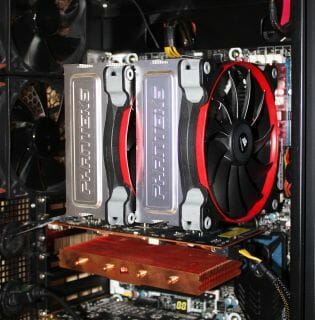
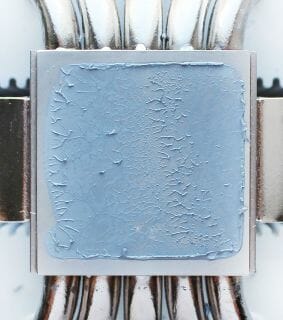
According to our preliminary tests, this modifications barely has hardly affected the cooling efficiency of this cooler, but has dramatically improved its acoustic performance. Nevertheless, the noise graph below will also have the curve for the Phanteks PH-TC14PE with the default fans for your reference.
Besides the super-cooler, NZXT Kraken X40 will also compete against the best closed-loop liquid-cooling system of all we have tested so far – Corsair H100i Extreme Performance:
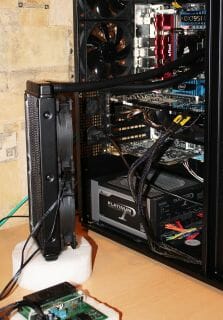
As you can see, this system was tested in identical conditions as NZXT Kraken X40 and not inside the system case. I would like to add that the rotation speed of all fans was controlled using our special in-house controller with ±10 RPM precision.
Performance
Cooling Efficiency
The results of our testing can be seen in this table as well as in the following diagram:
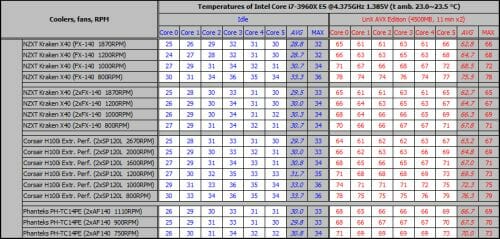
As you can see, the NZXT Kraken X40, unlike the majority of compact liquid cooling systems we tested earlier, looks very good even in its default configuration with one 140mm fan. The large radiator and high-performance pump make it competitive against the Phanteks PH-TC14PE as well as the Corsair H100i Extreme Performance. With its 140mm fan working at 1870 RPM, the NZXT Kraken X40 turned out to be more efficient than its opponents, beating the air super-cooler by 3°C in terms of peak CPU temperature. At 1200 and 1000 RPM the Kraken X40 is also efficient, competing with the Phanteks PH-TC14PE and easily beating the Corsair H100i when the latter’s two fans work at 1200 RPM or lower. However, when the speed of the Kraken X40’s fan is reduced to 800 RPM, the CPU temperature grows by 5°C, so the air super-cooler looks preferable (at its 750 RPM). The Kraken X40 is ahead of the Corsair H100i at the minimum speed of the fan, though.
It is after we install an additional 140mm fan on the Kraken X40’s radiator that it delivers truly impressive performance. It has no rivals in this case, especially at 800 RPM when the second fan helps lower the temperature by 7°C! Take note that the Corsair H100i can deliver the same 71°C only at 1600 RPM. Just an excellent result!
Then we checked out the NZXT Kraken X40 with our CPU overclocked to 4.5 GHz at a voltage of 1.435 volts. Here’s a table with results and a diagram too:
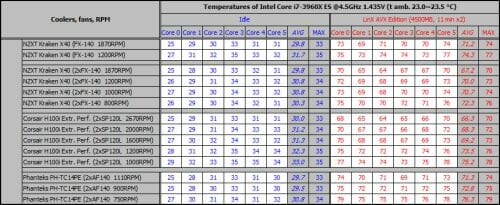
The Kraken X40 couldn’t cope with the overclocked CPU in the default configuration with one fan rotating at 1000 and 800 RPM. The Corsair H100i Extreme Performance also failed at 800 RPM. The overall picture is the same, though. The standard Kraken X40 is somewhat better than the Phanteks PH-TC14PE and comparable to the Corsair H100i. The additional 140mm fan improves the Kraken X40’s performance dramatically, making it superior to the Corsair H100i, which is the best ready-made liquid cooling system, in the speed range of 800-1200 RPM, notwithstanding its smaller size and lower price. The 140mm radiator and fan(s) are an advantage indeed.
We tried to check out the Kraken X40 at the highest frequency of our CPU (4.625 GHz at 1.49 volts) but our attempts were futile even when we installed a second fan on it. We always got an error message in the end:
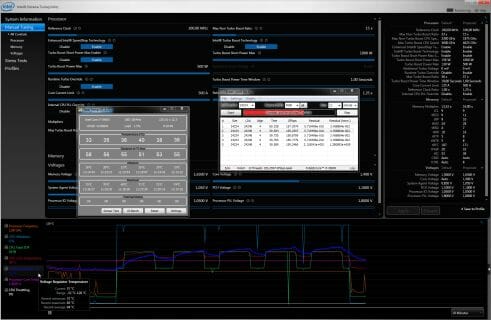
So, we finished our performance tests and proceeded to measure noise.
Noise
First of all, we want to say a few words about the pump. It turned out to be extremely quiet against the background noise of our quiet testbed. Measured according to our method, its noise level was 34.2 dBA. It’s comparable to the noise of a high-quality 120mm fan at a speed of 900-950 RPM. The operation of the pump is not accompanied by unwanted sounds from the electric motor or anything. The idyllic picture is only somewhat disturbed by air bubbles occasionally going through the pipes and radiator. So, the pump is excellent in this respect. Let’s check out the fan, which is the main source of noise in the Kraken X40 system.
We measured the noise level of each fan throughout its entire speed range according to the method explained in the previous section. Here are the results:
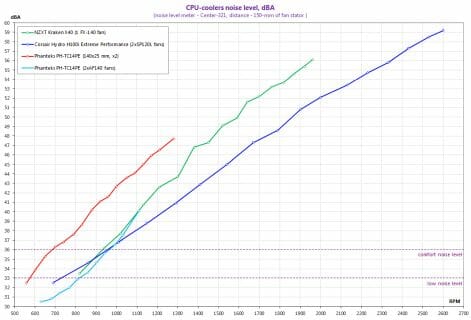
The three cooling systems don’t differ much in terms of noise at low fan speeds (up to 1050 RPM) except for the Phanteks PH-TC14PE in its default configuration with two fans. The NZXT Kraken X40 remains comfortable acoustically until a speed of about 930 RPM. Its fan is quiet at 800-820 RPM, which is the minimum speed we tested it at. However, at speeds above 1050 RPM the large 140mm fan from NZXT is noisier than the two Corsair fans of the H100i cooler. The difference is quite large at the same speed, although the Corsair cooler is louder at the maximum speed of the fans. We can also note that the NZXT is somewhat more agreeable than the Corsair when the fan speed is low.
Conclusion
The product we’ve tested today doesn’t push the performance bar of compact liquid cooling systems to a whole new level, yet the Kraken X40 indeed improves the general standing of such solutions in comparison with air CPU coolers. In its standard configuration the Kraken X40 is as good as the best air cooler and even beats it in the high-speed mode. Compact liquid cooling systems couldn’t even dream of such performance before.
Moreover, when equipped with two 140mm fans the Kraken X40 is competitive against the more expensive Corsair H100i Extreme Performance, let alone the air cooler. So, products of this type seem to be evolving in the right direction in terms of performance.
The NZXT Kraken X40 is only compatible with computer cases that have a place for a 140mm fan. Although the compatibility list already includes 50 models and keeps on expanding, such cases are less common than regular ones with 120mm fans. On the other hand, the Kraken X40 supports as many platforms as possible, including every CPU from both Intel and AMD. The installation procedure is extremely simple, the fastening mechanism is reliable, and the long pipes allow to place the radiator with fan anywhere in the computer case. Its price of $99 is higher than the price of mainstream liquid cooling systems with 120mm fans but not high compared to premium solutions or the Corsair H100i.
P.S.: The NZXT Kraken X40 would be just perfect if it had a copper radiator with two 140mm fans by default (and at its current price). Alas, this is hardly possible.